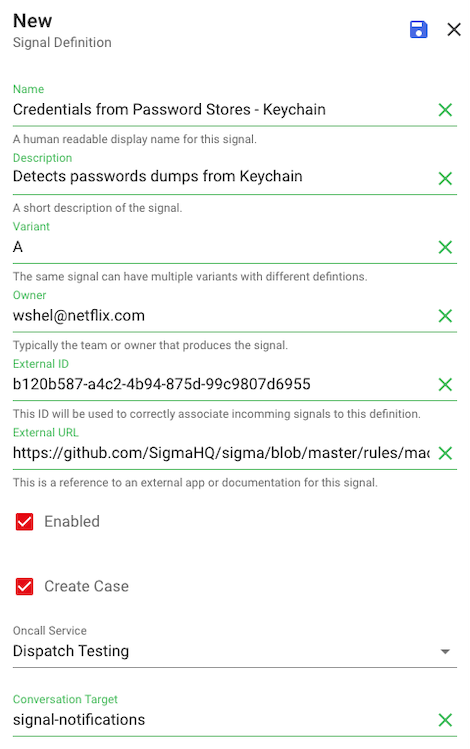Signal Definition
Signal Definitions are your starting point for onboarding a new Signal into Dispatch and allow a number of different configuration options.
Sending Signals to Dispatch
You can send a signal to Dispatch by making a POST request to the /{organization}/signals/instances API endpoint.
import requests
API_TOKEN = ""
API_ENDPOINT = "http://localhost:8080/api/v1/default/signals/instances"
signal_instance = {
"project": "Test",
"raw": {
"name": "process_events",
"externalId": "someExternalValue",
"id": "<uuid>", # this will be used as the instance's uuid if provided
"variant": "A" , # an additional indicator for signal subtypes
"hostIdentifier": "host1",
"calendarTime": "2022-10-19T10:35:01Z",
"time": 1618698901,
"columns": {
"pid": 888,
"path": "/usr/bin/security",
"cmdline": "/usr/bin/security dump-keychain",
"state": "running",
"parent": 555,
"created_at": 1918698901,
"updated_at": 2118698901
}
}
}
requests.Session()
r = session.post(
API_ENDPOINT,
json=signal_instance,
headers={
"Content-Type": "application/json",
"Authorization": f"Bearer {API_TOKEN}",
},
)
You can view the full API documentation for the /instances endpoint in the API Reference.
Creating a Signal Definition
At a high level, you'll need to configure some basic metadata about your signal such as the name, description, and variant.
You can also configure whether a signal should create a case or not. Choosing not to create a case can be useful for contextual signals that
don't necessarily warrant triage and investigation on their own. But, you can still use these signals to enrich other signals and cases.

Variant: The same signal can have multiple varitants with different definitions.
Owner: Typically the team or owner that produces the Siganl.
External ID: This ID will be used to correctly associate incoming signals to this definition. This ID should be unique across all Signal Definitions.
Conversation Target: Defines the channel name where the Case for the Signal will be created.